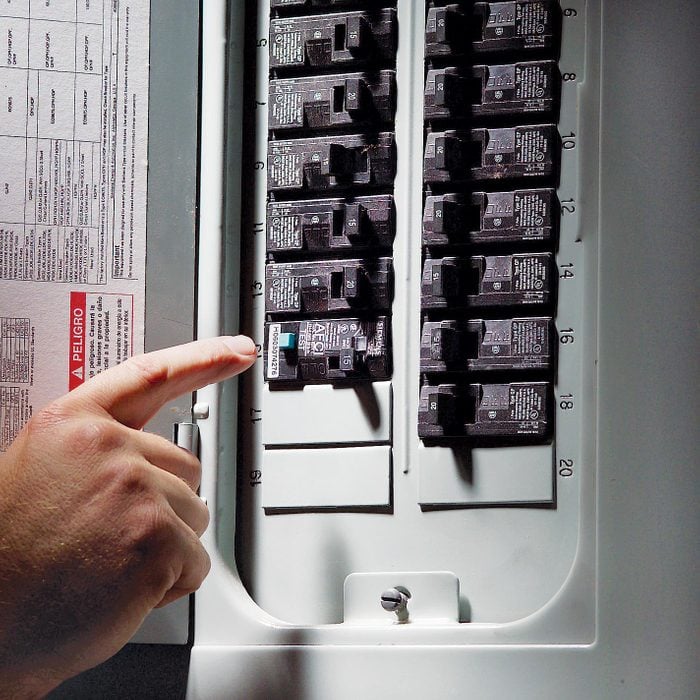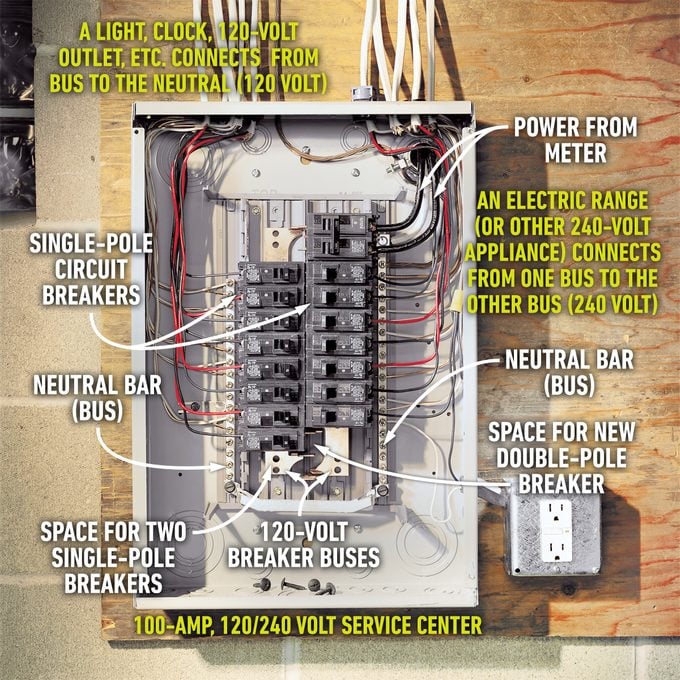Testing a Circuit Breaker Panel for 240-Volt Electrical Service
Updated: Mar. 19, 2024

Before you add a 240-volt appliance, you need to make sure you've got what it takes.
What to Look for in the Breaker Box
Unless your home is very old and has never had its electrical service updated, it has 240-volt service from the street and into the main electrical panel as well. While you’re at it, take this opportunity to learn about energy vampire for standby power that can make many of your appliances run 24 hours a day.(Also, explore what modern home buyers need in new home appliances.)
Nearly every main electrical panel has two 120-volt wires and one neutral wire running to it from the utility company. Each wire powers one “bus” (copper vertical leg) inside the main service panel. That’s why you usually see two columns of circuit breakers (or fuses) when you open your service panel door.
The common 120-volt circuits that power everything from your lava lamp to your vacuum cleaner are powered by one of those two buses. The standard 15- or 20-amp circuit breakers work by clipping onto one of the buses. Then the circuit’s hot (red or black) feed wire is clamped to the circuit breaker, while the neutral (white) wire and bare copper ground wire are clamped to the common neutral bar.
The way you get a 240-volt circuit is simple. A “double-pole” circuit breaker is clipped into both 120 buses at the same time, so the voltage to the circuit is doubled. That’s why these circuits have two hot wires, a neutral, and a ground at their 240-volt outlet to carry electricity to the appliance.
Do you have enough amperage capacity in the service panel for a new 240-volt appliance?
Service panels are rated for the maximum amps they can provide. A 60-amp panel found in an older home, for example, can handle up to 60 amps of current to the house. The panel has to be large enough to handle the existing electrical demand of the house plus the new appliance without exceeding the panel’s amperage rating. (A standard, no-frills electric range needs 40 amps.) Figuring this out is more complicated than simply calculating the electrical load of the circuit breakers already in the panel.
The electrician you hire to install the new circuit will help you decide if the panel is up to the task. Most home electrical panels have plenty of power for extra appliances, but if you have to increase the capacity, there are solutions. Most likely, if you have enough circuit spaces, you’ll have no problem adding the range circuit, especially if you don’t have any 240-volt power-hungry appliances like air conditioners, electric water heaters or dryers. Here are a few ideas for covering an electrical panel.

Is there physical space in the service panel for another double-pole 240-volt breaker?
Last, there have to be two spaces left in the panel for two additional circuit breakers. If the available spaces aren’t stacked directly above each other, existing breakers can be pulled and reinserted in new positions to provide that arrangement.
If you have an older panel that has fuses instead of breakers, or if the circuit breaker panel is already full, an electrician can add a subpanel to handle the extra 240-volt circuit. A subpanel is a mini electrical panel that is fed from the main panel to create spaces for more circuits. Adding a subpanel is relatively inexpensive, depending on how much work needs to be done and the condition of your service panel.
A subpanel probably isn’t worth the investment if you have a fused panel. It would be better to have the main home electrical panel upgraded to a modern circuit breaker panel–based one with plenty of room for extra circuits. Putting in a larger panel with higher amperage capacity may be several times the cost of a subpanel. It also might entail improving the home’s electrical system to bring it in line with local or national electric code requirements, a substantial additional expense.
Next: Check out homeowner’s guide to an AC fuse box.